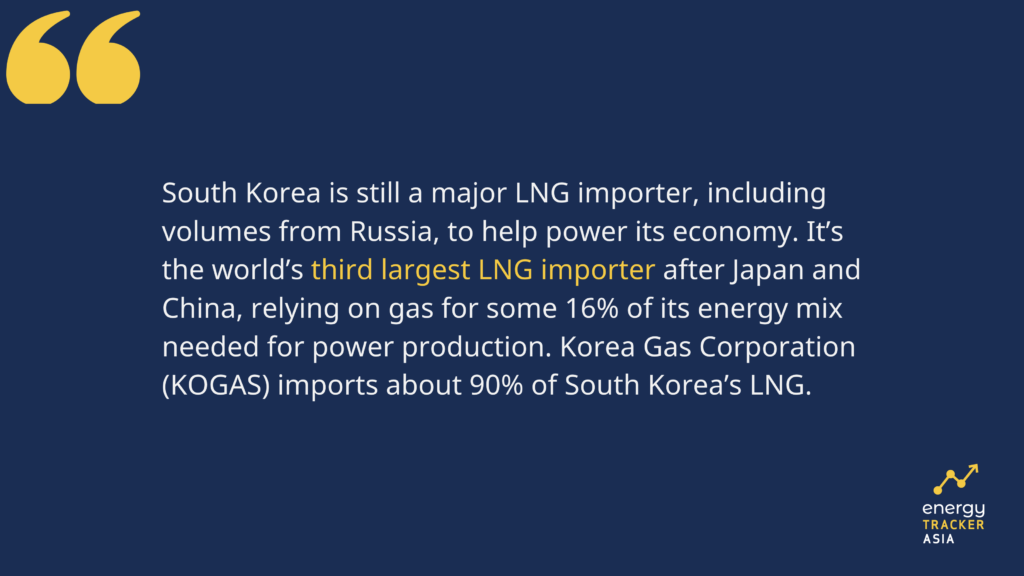South Korea’s LNG Reliance
Photo by Jouni Niskakoski
13 December 2022 – by Tim Daiss Comments (0)
South Korea is deeply involved in the development of LNG import and gas-to-power infrastructure across the Asia-Pacific region. Much of the development is due to the country’s rampant economic growth.
The country of some 52 million people has successfully transformed itself from a low-income to a high-income economy. It is also a global leader in innovation and technology.
The government’s policies have resulted in real GDP growth averaging 5.45% annually between 1988 and 2019. The country’s economy reported its highest growth in a decade in 2021. It suffered a 0.9% contraction in 2020 due to economic headwinds from the COVID-19 pandemic. However, it has grown by 4% due to a strong recovery in consumption from both private and public sectors.
Exports, most notably electronics, semiconductors and petrochemicals, continue to fuel the country’s economic growth. These are primarily exported to regional trading partners in Asia.
LNG Reliance
South Korea is still one of the major LNG importers, including volumes from Russia, to help power its economy. It’s the world’s third largest LNG importer after Japan and China, relying on gas for some 16% of its energy mix needed for power generation.
Korea Gas Corporation (KOGAS) imports about 90% of South Korea’s LNG. As such, it retains a monopoly in the domestic wholesale market, with customers that include both power generation and city gas companies.
Investing in Liquefied Natural Gas Infrastructure
South Korea, much like Japan, is also a major LNG infrastructure investor in developing Asia. This is largely through Korea Gas Corp. signing joint LNG development and gas-to-power ventures with local companies. Its goal is to promulgate LNG as a bridge fuel to achieve net-zero goals.
However, as CO2 emissions from burning gas for power production are around 60% of that of burning coal, it’s an energy development model that needs reconfiguration.

The USD 127 Billion In Overseas Oil and Gas Funding Provided
South Korea’s public financial institutions, including the Export-Import Bank of Korea (KEXIM), Korea Trade Insurance Corp. (K-SURE) and Korea Development Bank (KDB), provided a “whopping USD 127 billion in support for overseas oil and gas projects from 2011 to 2020”.
Geographically, the Middle East has been the biggest host of projects financed by South Korean public funds (USD 35.3 billion) over the past 10 years, followed by Central Asia, which includes Uzbekistan, Turkmenistan and Russia (USD 10.1 billion). The rest of Asia (Southeast Asia, South Asia and East Asia) is the third largest, with USD 6.8 billion deployed to the region.
South Korean investment in LNG infrastructure development and gas-to-power projects is most acute in Vietnam and the Philippines. Vietnam, for its part, leads the region’s planned gas expansion. It currently has 56.3 GW in pre-construction and construction stages, according to a recent report.
The Philippines is next in the region, with some 29.9 GW in development. The report adds that the San Miguel Corporation’s (SMC) 14.1 GW of proposed projects accounts for about 50% of the planned gas expansion in the country and is the largest in the region.
Renewables Funding Pivot
However, South Korean funds (spearheaded by the KDB) should make a funding pivot. Organisations should move away from LNG and gas-to-power projects and towards more renewables build-out. Cost comparisons between renewables projects and LNG and gas projects favour more renewables development.
Increasingly, high imported LNG prices, both currently and forecasted over at least the mid-term, along with energy security and geopolitical factors, as well as climate change mitigation, all weigh heavily in favour of such a green pivot.
Moreover, several countries in the Asia-Pacific region, including Bangladesh and Pakistan, are already facing economic and political headwinds from switching to more LNG usage for their power sectors. Similar dynamics could unfold if Vietnam, the Philippines and other countries in the region follow their lead.
by Tim Daiss
Tim has been working in energy markets in the Asia-Pacific region for more than ten years. He was trained as an LNG and oil markets analyst and writer then switched to working in sustainable energy, including solar and wind power project financing and due diligence. He’s performed regulatory, geopolitical and market due diligence for energy projects in Vietnam, Thailand and Indonesia. He’s also worked as a consultant/advisor for US, UK and Singapore-based energy consultancies including Wood Mackenzie, Enerdata, S&P Global, KBR, Critical Resource, and others. He is the Chief Marketing Officer (CMO) for US-based lithium-sulfur EV battery start-up Bemp Research Corp.
Read more

